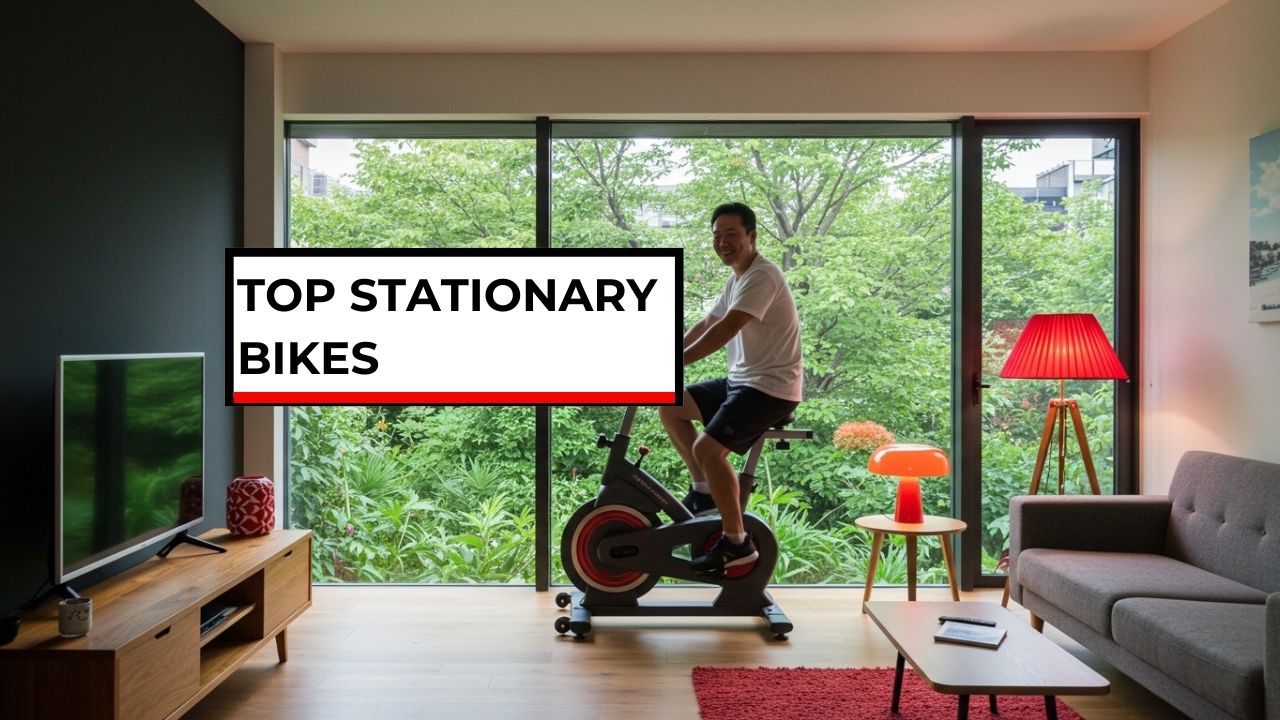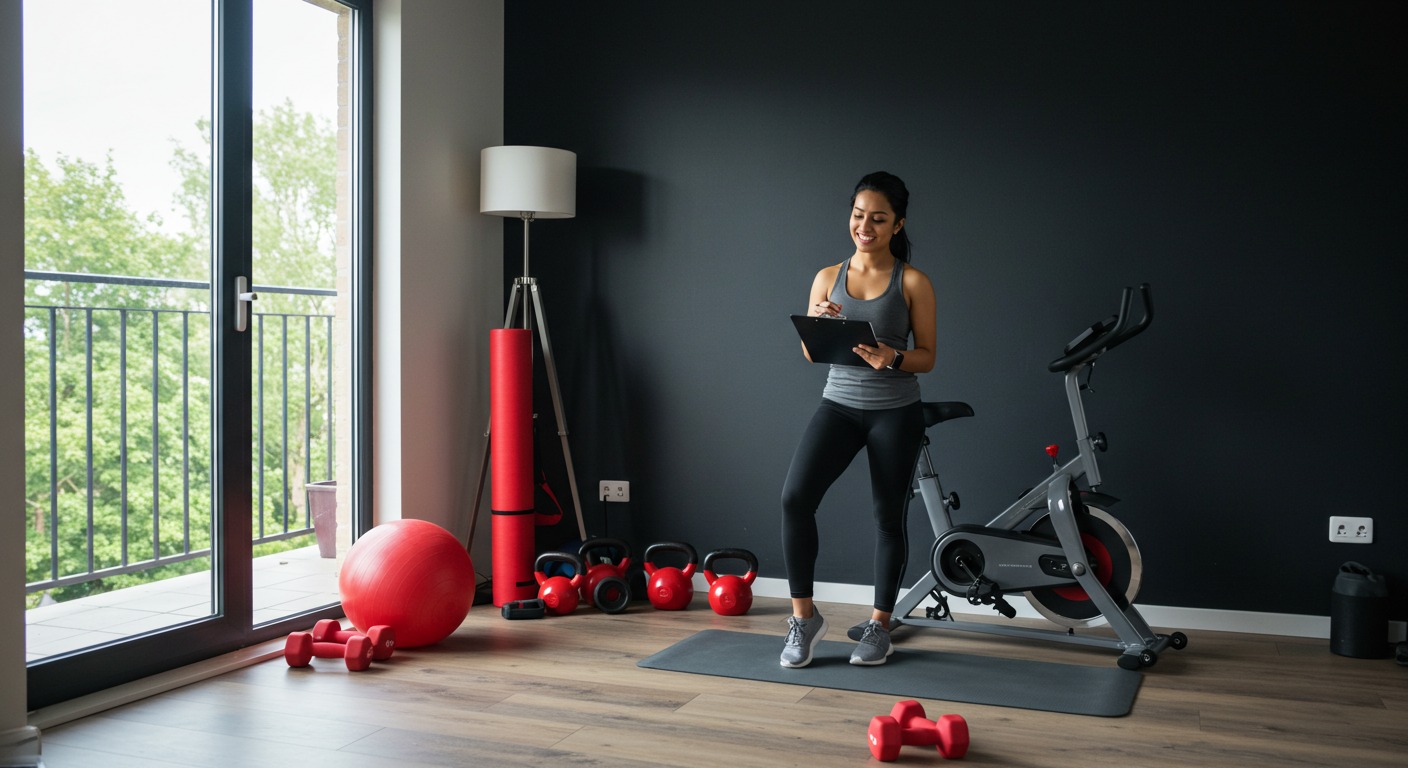Disclosure Information
This blog contains affiliate links. If you make a purchase through one of these links, our team may earn a commission at no extra cost to you. Learn more. Thanks for your support!
Finding time to visit the gym can be challenging in today’s busy world. That’s why stationary bikes have become a core tool in a typical home gym essentials checklist. Stationary bikes offer convenient and effective cardiovascular workouts regardless of weather or time constraints.
These versatile fitness machines provide low-impact exercise that’s gentle on joints while delivering exceptional cardiovascular benefits.
With numerous styles, features, and price points available, choosing the right stationary bike can feel overwhelming. This comprehensive guide will help you navigate the options to find the perfect stationary bike for your home cardio needs.
The Quick Overview: Best Stationary Bikes
- Upright Bikes: Best for general fitness – Schwinn 170
- Recumbent Bikes: Best for comfort and support – Sole R92
- Spin Bikes: Best for intense training – NordicTrack S15i
- Air Bikes: Best for full-body HIIT workouts – Rogue Echo
- Mini Exercise Bikes: Best for small spaces – Sunny Health & Fitness
- Budget Options: ~$169 (Body Rider Fan Bike) to ~$499 (Schwinn 130)
- Mid-Range Options: ~$599 (Schwinn Airdyne AD6) to ~$899 (Schwinn IC4)
- Premium Options: ~$1,055 (Rogue Echo) to ~$2,495 (Peloton Bike+)
Types of Stationary Bikes
Stationary bikes come in several distinct varieties, each designed for different workout experiences and fitness goals. Understanding these differences is crucial for selecting the right bike for your needs.
1. Upright Bikes
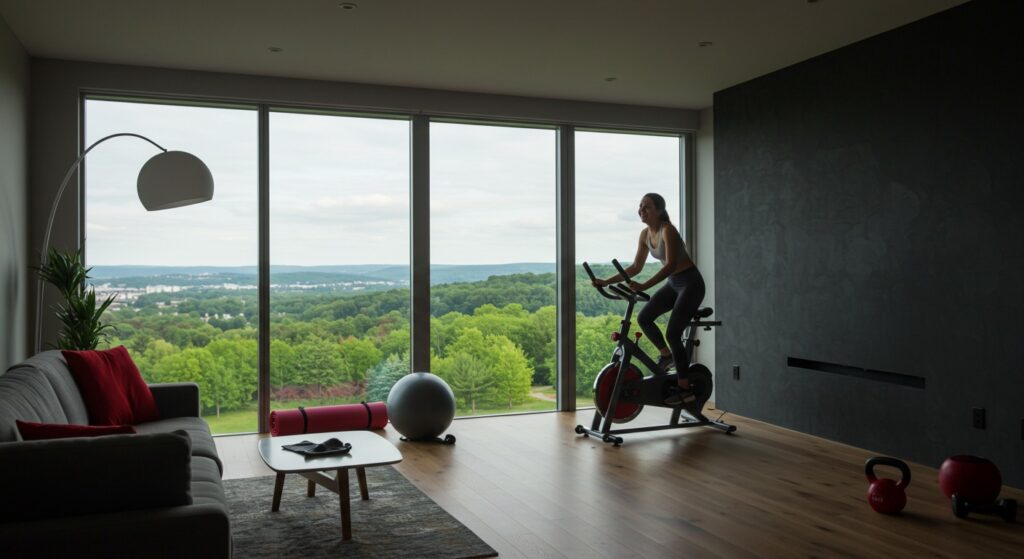
Upright bikes closely resemble traditional road bikes with a vertical riding position that engages core muscles while working your legs.
These bikes typically feature a smaller footprint than other styles, making them ideal for homes with limited space. The familiar positioning makes them accessible for most users, from beginners to experienced cyclists.
Best for: General fitness, moderate intensity workouts, smaller spaces
Pros: Compact design, familiar position, engages core muscles, affordable options available
Cons: Less comfortable for longer sessions, potential saddle discomfort, limited positioning options
Popular Options
FitCycle Pro 500
- 8 resistance levels
- Basic LCD display
- Compact folding design
- Heart rate sensors
- Max user weight: 275 lbs
LifeFitness C1 Upright (Available on Amazon)
- 16 resistance levels
- Backlit LCD console
- Ergonomic handlebars
- Whisper-quiet operation
- Max user weight: 300 lbs
Schwinn 170 Upright Bike
- 25 resistance levels
- 29 workout programs
- Bluetooth connectivity
- Sturdy frame
- Max user weight: 300 lbs
2. Recumbent Bikes
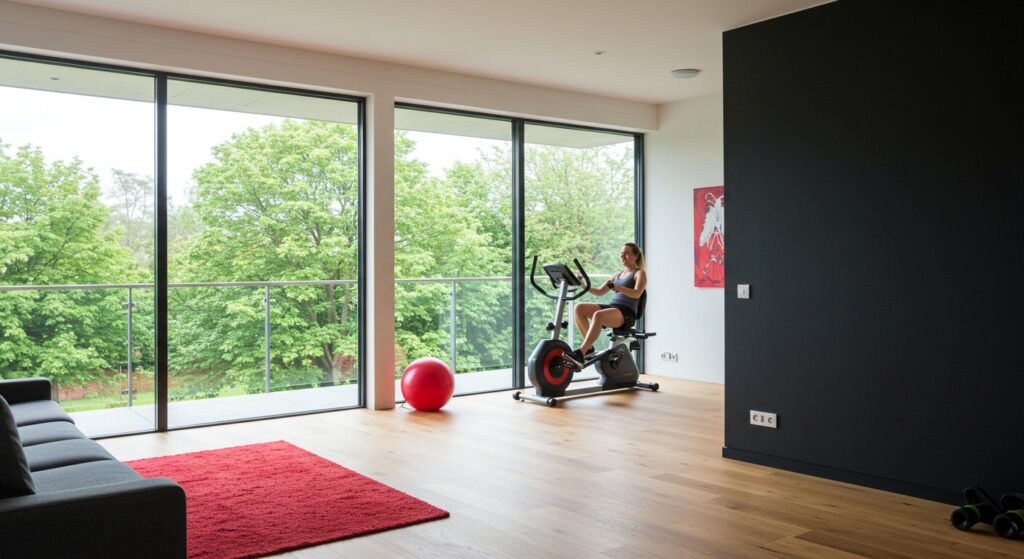
Recumbent bikes feature a laid-back seating position with a chair-like seat and backrest for optimal comfort and spinal support.
These bikes place riders in a semi-reclined position that reduces pressure on the lower back, making them perfect for users with mobility issues or those recovering from injuries. The step-through design allows for easy mounting and dismounting.
Best for: Seniors, rehabilitation, users with back pain, longer comfortable sessions
Pros: Superior comfort, excellent back support, safer for those with balance issues, less pressure on joints
Cons: Larger footprint, less core engagement, typically more expensive than uprights
Popular Options
Marcy ME-709 (Available on Amazon)
- 8 resistance levels
- Easy-to-read display
- Step-through design
- Adjustable seat
- Max user weight: 300 lbs
Nautilus R616
- 25 resistance levels
- 29 workout programs
- Bluetooth connectivity
- DualTrack LCD displays
- Max user weight: 325 lbs
Sole R92 Recumbent Bike
- Commercial-grade frame
- 20 resistance levels
- Adjustable gel seat
- Cooling fans
- Bluetooth speakers
- Premium workout experience
3. Spin Bikes
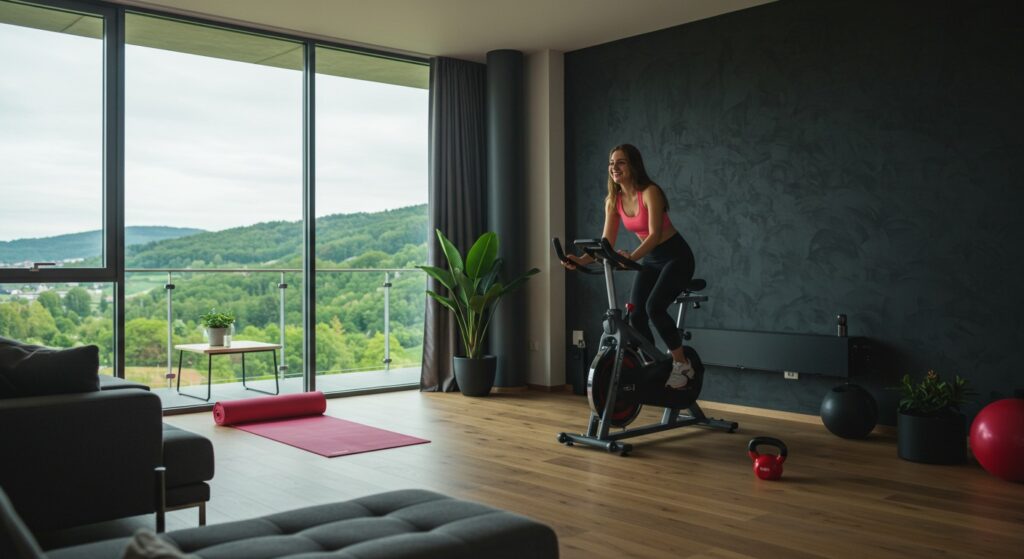
Spin bikes (also called indoor cycling bikes) are designed to simulate road cycling with a forward-leaning posture and weighted flywheel for momentum-based resistance.
These high-intensity bikes feature a heavy flywheel that creates momentum, providing a realistic riding experience. The adjustable resistance and ability to stand while pedaling make them ideal for intense interval training.
Best for: High-intensity interval training, cyclists seeking road-like experience, advanced workouts
Pros: Most authentic cycling feel, highly adjustable, excellent for intense cardio, strengthens quads and glutes
Cons: Less comfortable for beginners, steeper learning curve, typically less tech features
Popular Options
Sunny Health & Fitness Pro (Available on Amazon)
- 40-pound flywheel
- Adjustable resistance
- Fully adjustable seat
- Caged pedals
- Max user weight: 275 lbs
Keiser M3i (Available on Amazon)
- Magnetic resistance
- Bluetooth connectivity
- Performance tracking
- Virtually silent operation
- Max user weight: 350 lbs
NordicTrack Commercial S15i Studio Cycle (Available on Amazon)
- Automatic resistance control
- Incline/decline capability
- 14-inch touchscreen
- Live and on-demand classes
- Max user weight: 350 lbs
4. Air Bikes
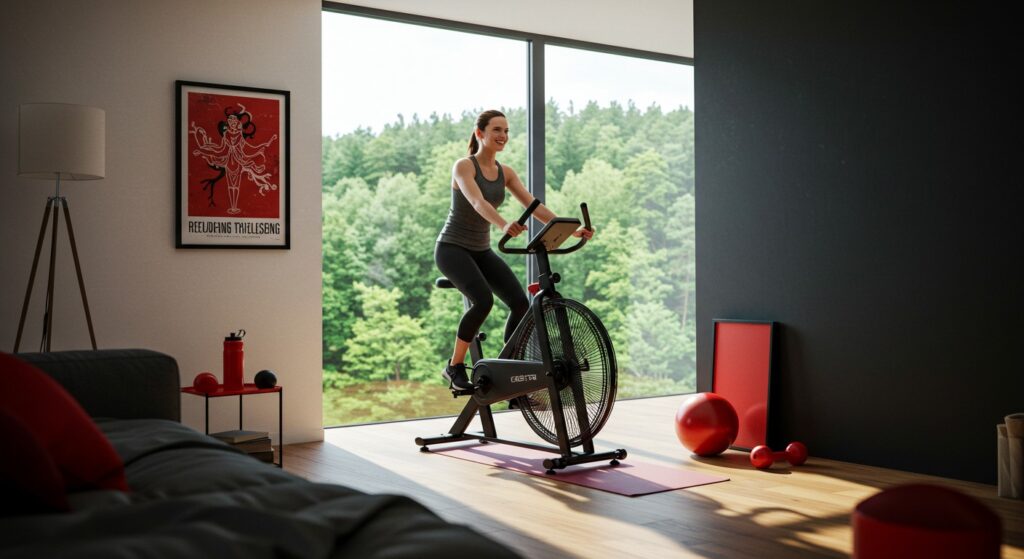
Air bikes (or fan bikes) use a large fan that generates both resistance and cooling airflow as you pedal, with intensity increasing the harder you work.
These bikes typically feature moving handlebars that engage your upper body for a true full-body workout. The unlimited air resistance makes them incredibly challenging for HIIT workouts and CrossFit-style training.
Best for: HIIT workouts, full-body training, CrossFit enthusiasts, varied intensity
Pros: Self-regulated resistance, upper body engagement, cooling effect, virtually unlimited resistance
Cons: Louder operation, less comfortable for steady-state cardio, minimal tech features
Popular Options
Assault AirBike Classic (Available on Amazon)
- Unlimited air resistance
- Moving arm handles
- Basic performance monitor
- Heavy-duty steel frame
- Max user weight: 350 lbs
Schwinn Airdyne AD7 (Available on Amazon)
- Belt drive system
- Multi-position handlebars
- LCD console with programs
- Water bottle holder
- Max user weight: 350 lbs
Rogue Echo Bike
- Belt drive system for smoother operation
- Heavy-duty steel frame
- Performance console for tracking
- Tank-like durability
- Max user weight: 350 lbs
5. Mini Exercise Bikes

Mini exercise bikes (or under-desk bikes) are compact devices featuring only the pedal mechanism, allowing for flexibility in usage and storage.
These space-saving units can be used while seated in a regular chair or even under a desk during work hours. They’re perfect for those with minimal space or who want to incorporate movement throughout the day.
Best for: Small spaces, multitasking, light exercise, rehabilitation
Pros: Extremely compact, affordable, portable, can be used while doing other activities
Cons: Limited workout intensity, fewer features, less stability, minimal resistance options
Popular Options
DeskCycle Under Desk Bike (Available on Amazon)
- 8 resistance levels
- LCD display
- Whisper-quiet operation
- Fits under 27″ desks
- Smooth pedal motion
Cubii Jr1 Seated Elliptical (Available on Amazon)
- 8 resistance levels
- LCD monitor
- Compact design
- Forward and backward pedaling
- Built-in handle for portability
Sunny Health & Fitness Magnetic Mini Exercise Bike (Available on Amazon)
- 8 magnetic resistance levels
- Digital monitor
- Versatile for legs or arms
- Compact design
- Portable with built-in handle
Best Stationary Bikes by Budget

Budget-Friendly Options ($200-$500)
Perfect for beginners or those testing the waters with home cardio equipment. These bikes offer essential features without breaking the bank.
Best Upright: Schwinn 130 Upright Bike
- 16 resistance levels
- 13 workout programs
- Media shelf and USB charging
- Adjustable fan
- Price: ~$499
Best Recumbent: Marcy ME-709 Recumbent
- 8 magnetic resistance levels
- Easy-to-read computer
- Step-through design
- Comfortable padded seat
- Price: ~$299
Best Spin Bike: YOSUDA Indoor Cycling Bike
- 35-pound flywheel
- Adjustable cage pedals
- iPad mount
- Comfortable seat cushion
- Price: ~$299
Best Air Bike: Body Rider Fan Bike
- Dual-action arms
- Adjustable seat
- Simple fitness monitor
- Compact footprint
- Price: ~$169
Mid-Range Options ($500-$1,000)
These bikes offer a substantial upgrade in quality, features, and durability without reaching premium price points.
Best Upright: Schwinn 170 Upright Bike
- 25 resistance levels
- 29 workout programs
- Bluetooth connectivity
- Adjustable fan and media shelf
- Price: ~$649
Best Recumbent: Nautilus R616 Recumbent
- 25 resistance levels
- 29 programs
- Bluetooth connectivity
- DualTrack LCD displays
- Price: ~$799
Best Spin Bike: Schwinn IC4 Indoor Cycling Bike
- 100 micro-adjustable resistance levels
- Full-color backlit LCD display
- Bluetooth connectivity
- Dual water bottle holders
- Price: ~$899
Best Air Bike: Schwinn Airdyne AD6
- Progressive wind resistance
- RevMeter RPM gauge
- Self-balancing foot pedals
- Quiet operation
- Price: ~$599
Premium Options ($1,000+)
For serious fitness enthusiasts, these high-end bikes offer exceptional build quality, advanced technology, and immersive workout experiences.
Best Upright: Life Fitness C3 Upright Bike
- 20 resistance levels
- Track Connect console
- Comfort Curve seat
- Self-powered design
- Price: ~$1,899
Best Recumbent: NordicTrack Commercial R35
- 26 digital resistance levels
- 14″ HD touchscreen
- iFit membership included
- OneTouch controls
- Price: ~$1,499
Best Spin Bike: Peloton Bike+
- Digital resistance control
- 23.8″ rotating HD touchscreen
- Live and on-demand classes
- Auto-Follow resistance
- Price: ~$2,495
Best Air Bike: Rogue Echo Bike
- Belt-driven fan
- LCD console
- Heavy-duty steel construction
- Built-in wind guard
- Price: ~$1,055
Best Stationary Bikes by Feature

Best for Interactive Training
- Immersive 23.8″ rotating touchscreen
- Live and on-demand classes
- Performance tracking and leaderboards
- Auto-Follow resistance adjustments
- Music and instructor integration
- 22″ rotating smart HD touchscreen
- iFit membership with global workouts
- Automatic trainer control of resistance
- Incline/decline capability (-10% to 20%)
- Live interaction with trainers
Best for Small Spaces
Slim Cycle 2-in-1 Stationary Bike
- Folds to half its size for storage
- 2-in-1 upright and recumbent positions
- Built-in arm resistance bands
- Digital monitor
- 300 lb weight capacity
XTERRA Fitness FB150 Folding Bike
- X-frame design folds to 18″ x 18″ footprint
- 8 resistance levels
- Large anatomically designed seat
- Multi-grip handlebars
- Easy-to-read LCD display
Best for Heavy Users
Sole LCB Light Commercial Upright Bike
- Commercial-grade frame
- 40-pound flywheel
- 350 lb weight capacity
- Oversized pedals with straps
- Lifetime frame warranty
Diamondback 910SR Recumbent Bike
- Heavy-duty step-through frame
- 32 resistance levels
- 450 lb weight capacity
- Adjustable cooling fan
- Integrated speakers
Best for Quiet Operation
- Virtually silent magnetic resistance
- Belt drive system
- Bluetooth connectivity
- Maintenance-free design
- V-shape frame accommodates riders of all sizes
- Whisper-quiet magnetic resistance
- 22″ HD touchscreen
- 32 resistance levels
- Bluetooth heart rate compatibility
- Rotating console for off-bike workouts
Understanding Stationary Bike Features
When selecting a stationary bike, consider these key features:
1. Resistance System
The mechanism that creates tension against your pedaling:
Magnetic: Quiet, smooth, requires minimal maintenance
Friction: Direct contact creates resistance, more affordable but wears over time
Air/Fan: Resistance increases with effort, provides cooling but noisier
Electromagnetic: Digitally controlled resistance, precise but more expensive
2. Console and Technology
The digital interface that displays workout information and controls:
Basic: Simple display showing speed, time, distance, and calories
Intermediate: Backlit display with preset programs and heart rate monitoring
Advanced: HD touchscreens with streaming content, app connectivity, and performance tracking
3. Drive System
The mechanism that transfers power from pedals to resistance:
Chain Drive: Similar to regular bikes, durable but requires maintenance
Belt Drive: Smoother, quieter operation with less maintenance
Direct Drive: Connects flywheel directly to pedals for most realistic feel
4. Comfort Features
Elements that enhance the riding experience:
Seat Design: Padding, width, ergonomic shape
Adjustability: Horizontal and vertical seat adjustments, handlebar positions
Extras: Water bottle holders, media racks, cooling fans, built-in speakers
5. Stability and Construction
The overall build quality that determines durability and safety:
Frame Material: Steel, aluminum, or composite materials
Weight Capacity: Maximum user weight the bike can safely support
Stabilizers: Features that prevent wobbling during intense workouts
Size and Footprint: Space required and portability options
Choosing the Right Stationary Bike
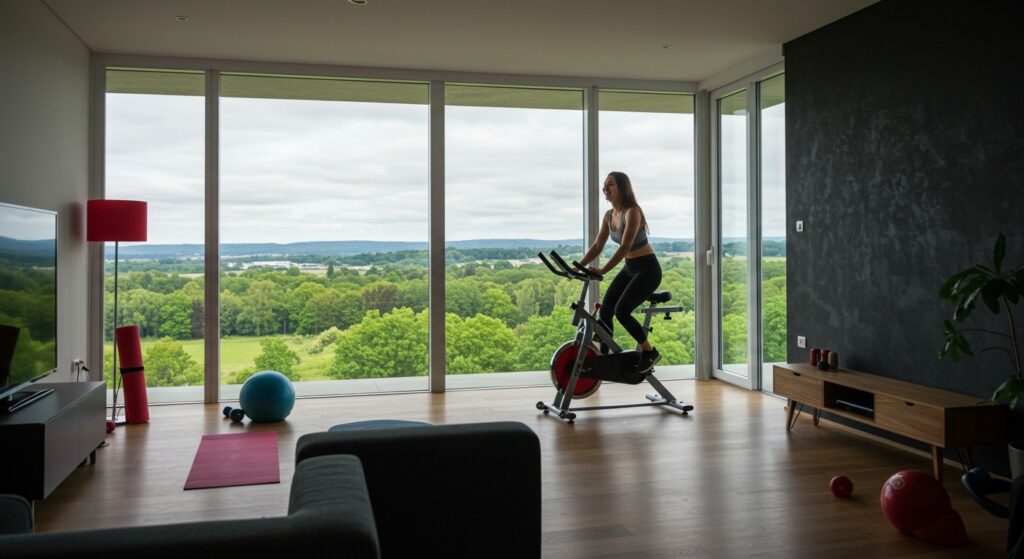
Consider these factors when selecting a stationary bike for your home workout:
Fitness Goals
Weight Loss and General Fitness
Any bike type can help, but upright bikes offer a good balance of comfort and effectiveness. Look for programs with varied intensities to keep workouts interesting.
Training for Cycling Events
Spin bikes provide the most realistic road cycling experience. Choose models with performance tracking and adjustable positioning similar to a road bike.
Low-Impact Exercise
Recumbent bikes offer the gentlest workout experience, ideal for those with joint issues, seniors, or those recovering from injuries.
High-Intensity Interval Training
Air bikes and spin bikes excel at high-intensity workouts due to their unlimited resistance and ability to quickly transition between effort levels.
Physical Considerations
Joint and Back Issues
Choose a recumbent bike for maximum back support and minimal joint stress. The reclined position distributes weight more evenly.
Height and Weight
Check the bike’s weight capacity and adjustment ranges. Taller users (over 6’2″) should verify maximum seat height, while shorter users (under 5’3″) should confirm minimum settings.
Fitness Level
Beginners might prefer recumbent or upright bikes for their stability and comfort. Advanced users often gravitate toward spin bikes for their intensity and adjustability.
Space Considerations
Available Room
Measure your workout space carefully, allowing for:
- 2 feet of clearance on all sides for safety
- Ceiling height (especially for spin bikes when standing)
- Storage options if space is limited
Permanent vs. Portable
If you need to move your bike regularly, look for models with transport wheels or folding capabilities. Note that more portable bikes may sacrifice some stability.
Budget Considerations
Beyond the initial purchase price, consider:
- Subscription Costs: Some interactive bikes require monthly memberships
- Warranty Coverage: Longer warranties may justify higher upfront costs
- Maintenance Requirements: Some bikes need regular part replacements
- Resale Value: Higher-quality brands typically retain more value
Comparing Stationary Bike Types
| Bike Type | Best For | Space Required |
| Upright | General Fitness | Small-Medium |
| Recumbent | Comfort & Rehab | Large |
| Spin | Intense Training | Medium |
| Air | Full-Body HIIT | Medium-Large |
| Mini | Limited Space | Minimal |
Maintenance Tips for Stationary Bikes
Proper maintenance extends the life of your stationary bike and ensures safe, effective workouts.
Daily and Weekly Care
- Wipe down the frame after each use to prevent sweat corrosion
- Check pedals and seat for proper tightness weekly
- Inspect moving parts for unusual sounds or resistance
Monthly Maintenance
- Lubricate the chain (for chain-drive models) according to manufacturer guidelines
- Check and tighten all bolts and connection points
- Clean beneath and around the bike to prevent dust buildup
- Inspect the power cord (if applicable) for wear or damage
Quarterly and Annual Service
- Check and calibrate the resistance system
- Inspect the belt or chain for signs of wear
- Lubricate bearings as recommended by the manufacturer
- Update console firmware if applicable
Bike-Specific Maintenance
Upright and Recumbent Bikes
- Adjust seat mechanisms to prevent wobbling
- Check electronic connections for console functions
Spin Bikes
- Regularly check flywheel alignment
- Inspect brake pads for wear (friction-based models)
Air Bikes
- Clean fan cage to remove dust and debris
- Check arm linkages for proper movement
Getting the Most from Your Stationary Bike
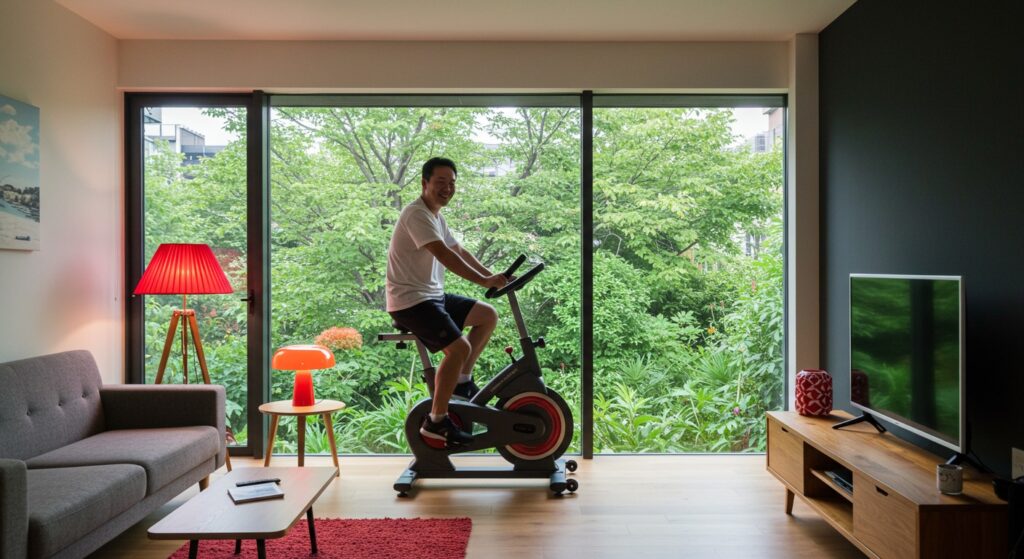
Creating an Effective Workout Routine
A successful stationary bike routine balances consistency, variety, and progression:
- Start gradually: Begin with 10-15 minute sessions if you’re new to cycling
- Build endurance: Add 5 minutes weekly until reaching 30-45 minute sessions
- Incorporate variety: Mix steady-state cardio with interval training
- Schedule regular sessions: Aim for 3-5 cycling workouts per week
- Track progress: Record distance, resistance levels, and workout duration
Sample Workout Plans
Beginner Plan
- Monday: 15 minutes steady pace at low resistance
- Wednesday: 15 minutes alternating 2 minutes normal pace, 1 minute faster pace
- Friday: 15 minutes steady pace at slightly higher resistance than Monday
Intermediate Plan
- Monday: 30 minutes steady state at moderate resistance
- Wednesday: 25 minutes interval training (5 min warm-up, 5 sets of 2 min high intensity/2 min recovery, 5 min cool-down)
- Friday: 30 minutes hill program (increasing and decreasing resistance)
- Saturday: 20 minutes recovery ride at low resistance
Advanced Plan
- Monday: 45 minutes endurance ride at moderate resistance
- Tuesday: 30 minutes HIIT (5 min warm-up, 10 sets of 1 min max effort/1 min recovery, 5 min cool-down)
- Thursday: 45 minutes pyramid intervals (gradually increasing then decreasing intensity)
- Saturday: 60 minutes mixed terrain (simulating hills, flats, and varying resistance)
Enhancing Your Indoor Cycling Experience
Tech Add-ons
- Heart rate monitors for precise intensity management
- Cadence sensors to track pedaling speed
- Fitness apps that sync with your bike’s console
Comfort Improvements
- Padded seat covers for longer sessions
- Wireless headphones for entertainment
- Proper cycling shoes for improved power transfer
Entertainment Options
- Creating dedicated workout playlists
- Following virtual cycling routes via apps or videos
- Joining online cycling communities for motivation
Conclusion: Making Your Final Decision
Selecting the right stationary bike combines objective assessment of features with your personal preferences and goals.
Final Selection Checklist
- Test before purchasing whenever possible
- Read user reviews focusing on long-term ownership experiences
- Verify warranty terms and availability of replacement parts
- Consider future needs as your fitness levels improve
- Evaluate assembly requirements or professional setup options
The best stationary bike is ultimately the one you’ll use consistently. Prioritize features that will keep you motivated and comfortable during your workouts, as consistency is the key to achieving your fitness goals.
Whether you choose an upright bike for general fitness, a recumbent model for comfort, a spin bike for intense training, or an air bike for full-body workouts, incorporating regular cycling into your routine will deliver significant cardiovascular benefits and contribute to your overall health and wellbeing.

